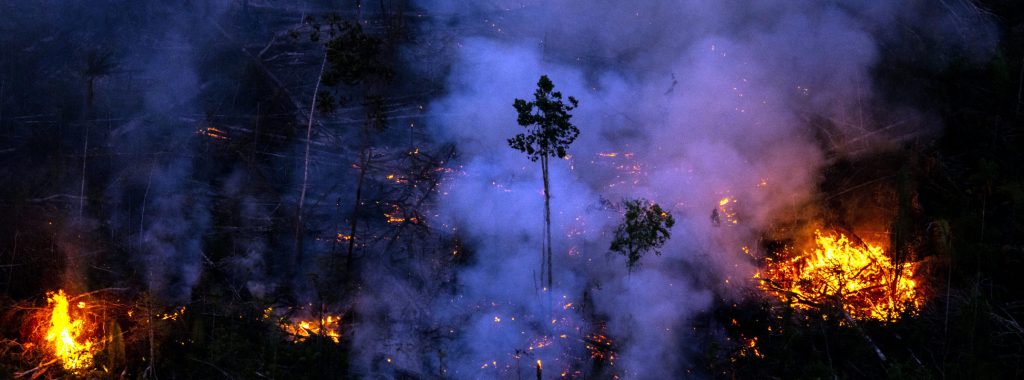Mongabay
Liz Kimbrough
20, septiembre de 2022
- Scientists warn that the Amazon is approaching a tipping point beyond which it would begin to transition from a lush tropical forest into a dry, degraded savanna. This point may be reached when 25% of the forest is lost.
- In a newly released report, the Monitoring of the Andean Amazon Project (MAAP) estimates that 13.2% of the original Amazon forest biome has been lost due to deforestation and other causes.
- However, when the map is divided into thirds, it shows that 31% of the eastern Amazon has been lost. Moisture cycles through the forest from east to west, creating up to half of all rainfall across the Amazon. The 31% figure is critical, the report says, “because the tipping point will likely be triggered in the east.”
- Experts say the upcoming elections in Brazil could have dramatic consequences for the Amazon, and to avert the tipping point we must lower emissions, undertake ambitious reforestation projects, and build an economy based on the standing forest. Granting and honoring Indigenous land tenure and protected areas are also key strategies.
Scientists warn that the Amazon is hurtling toward a tipping point, beyond which it would begin to transition from lush tropical forest into a dry, degraded savanna, unable to support the immense diversity of life that call the world’s largest rainforest home.
This change could be triggered when 25% of the forest has been lost under current climate pressures, scientists estimate. So how close are we to the tipping point? To answer that question, we need to know how much of the original Amazon forest biome has been lost.
“Surprisingly, we did not find any actual definitive studies that answered this question directly,” Matt Finer, senior research specialist and director of the Monitoring of the Andean Amazon Project (MAAP), a U.S.-based nonprofit, told Mongabay. So, about three years ago, MAAP set out to do exactly that.
In a newly released report, MAAP estimates that 13.2% of the original Amazon forest biome has been lost due to deforestation and other causes. This equates to more than 85 million hectares (211 million acres), an area about one-tenth the size of the United States or China.
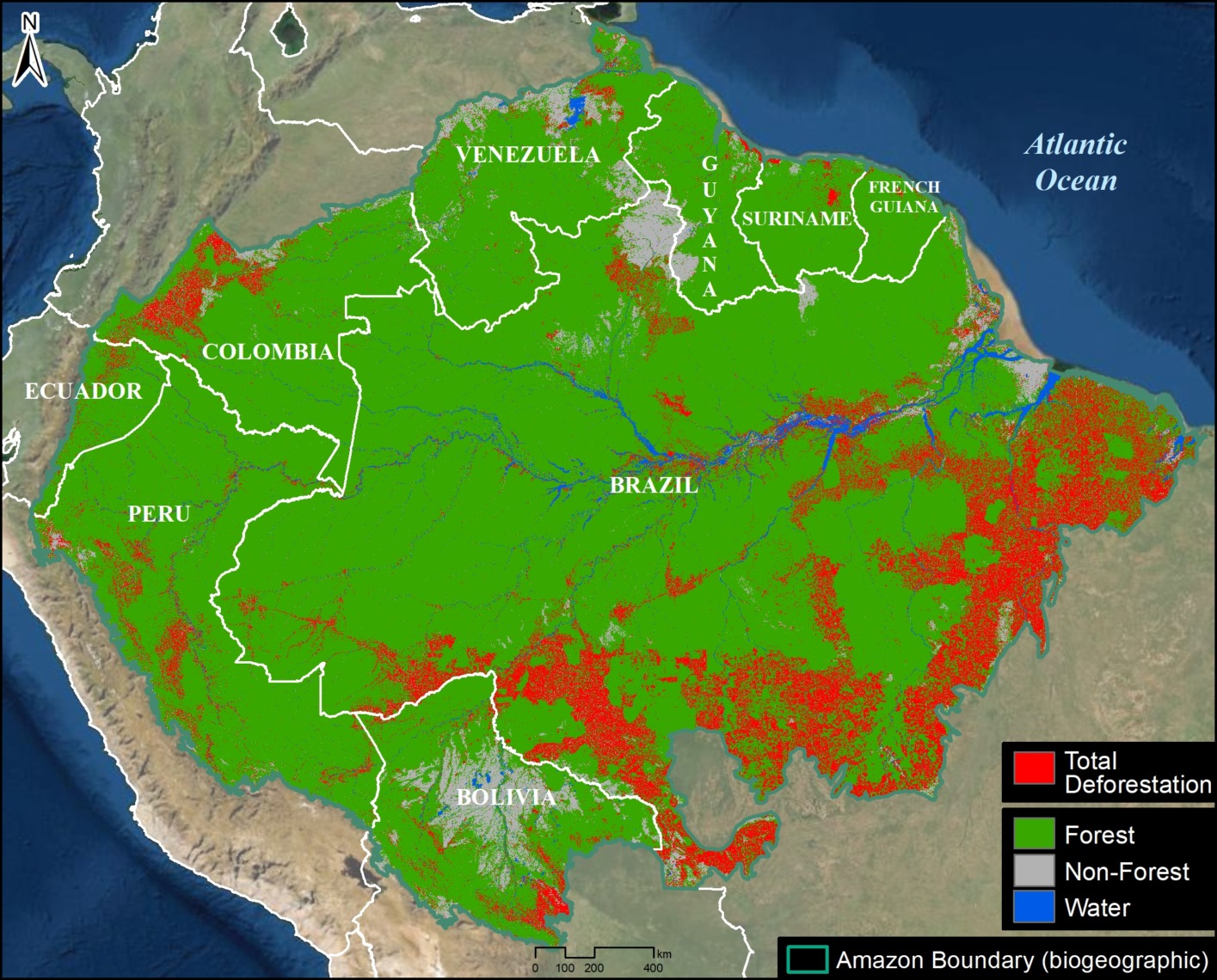
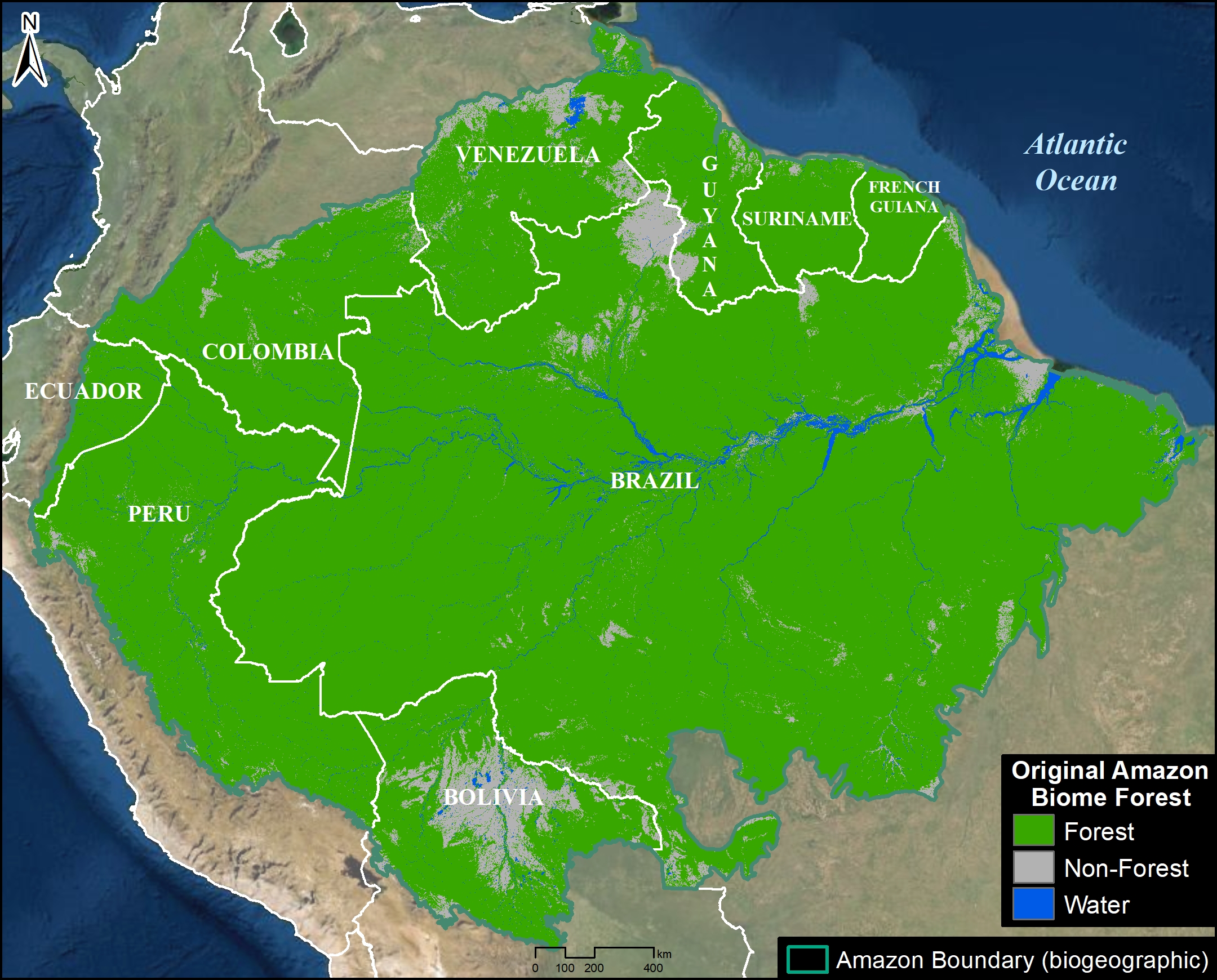
To arrive at this number, MAAP first had to create a map of the original Amazon biome, prior to European colonization, and then overlay the total historical forest loss. The researchers combined data from the University of Maryland, Brazil’s national space research institute (INPE), ArcGis satellite images, Planet mosaics, Google Earth Engine Landsat images, and official government data for several countries. They made modifications such as converting deforested areas and historic dam reservoirs to original forest to reconstruct the biome.
The MAAP highlights another critical number. When divided into thirds, the map shows that 31% of the eastern Amazon is gone. “This finding is critical,” the report says, “because the tipping point will likely be triggered in the east.” Tree loss in the east is significant because moisture cycles through the forest from east to west, creating up to 50% of all rainfall across the Amazon.
“Water for the Amazon is coming from the [Atlantic] ocean,” Finer said. “You see the map and all of a sudden realize, this is a whole different ballgame.”

The Amazon Rainforest gets up to half of its rain from moisture recycling. The sun warms the surface waters of the Atlantic Ocean and causes vapor to rise and form clouds. These clouds carry rain to the eastern Amazon. The forest absorbs the rain and then releases water vapor back into the atmosphere through transpiration. This water vapor from eastern forests is carried by winds to the west, and forms the Amazon’s “flying rivers,” which rain down in the west. Thus, deforestation in the east may have a more detrimental effect on the whole system.
“Deforestation is not created equal when you’re talking about the tipping point,” Finer said. “The real number to pay attention to is this 31%.”
Another recent study found that for every three trees that die due to drought in the Amazon Rainforest, a fourth tree, even if it’s not directly affected by drought, will also die. With fewer trees in the east to recycle moisture due to drought and deforestation, the rest of the Amazon becomes drier. “The lack of moisture recycling in some parts of the forest can be propagated downwind … resulting in approximately one-third of all tipping events,” the paper says.
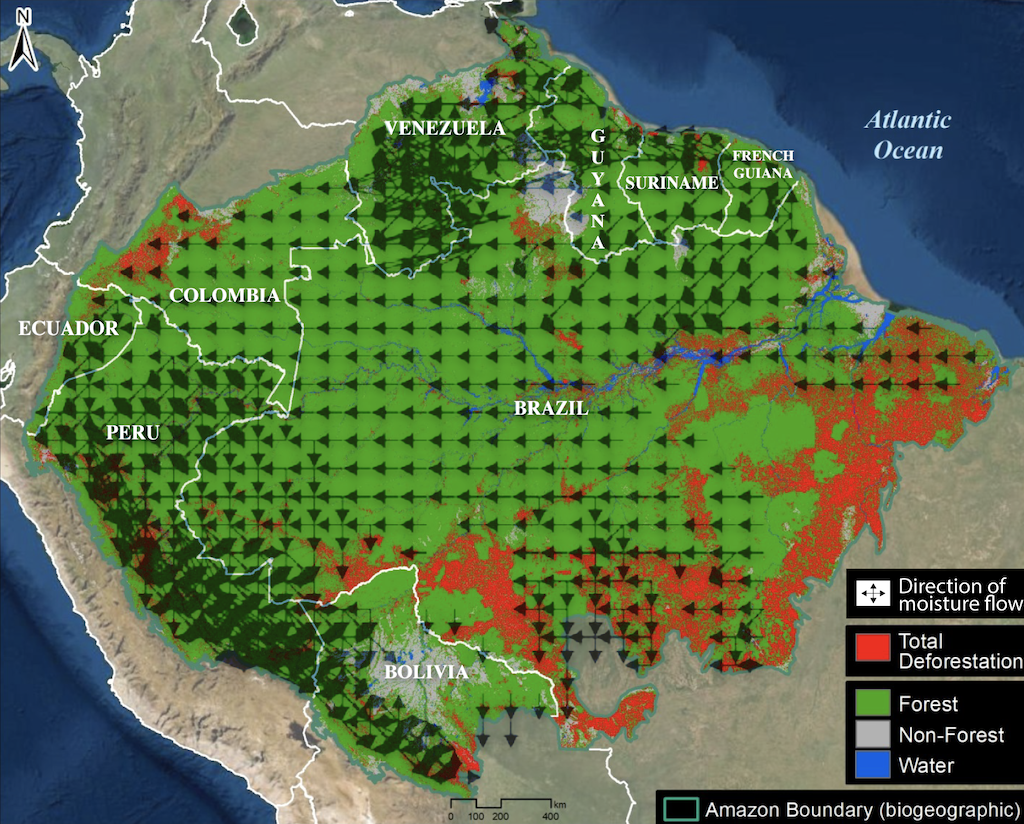

When it was first conceived, the tipping point concept was thought of as an abrupt ecosystem change, “but it is now believed that the shift could happen gradually,” over the course of 30 to 50 years, the MAAP report says.
Rather than thinking of the Amazon Rainforest as “one big tipping element that will vanish from Earth past a certain threshold,” it’s helpful to note that some regions are much more vulnerable to tipping than other regions, Nico Wunderling, a researcher at the Potsdam Institute for Climate Impact Research, who was not involved in the MAAP report, told Mongabay.
The southern region of the Amazon, Wunderling and colleagues found, is most vulnerable. Here, deforestation is at its most extreme along the notorious “arc of deforestation” being carved into the rainforest by cattle ranching and agriculture.
“I don’t think there’s a point beyond which the whole Amazon collapses,” Daniel Nepstad, president of the Earth Innovation Institute, told Mongabay in a 2019 interview. “It is all a question of how frequent and intense those really severe droughts are.”
The first signs of more permanent drying and more severe droughts in the rainforest are already showing, scientists warn. Plant species adapted to wet conditions are starting to die, and satellite images show a decrease in water vapor over parts of the rainforest that are far from the arc of deforestation.
“Not only is the dry season lengthier, but also it’s drier, with less rainfall, and 2-3° [Celsius, or 3.6-5.4° Fahrenheit] warmer,” Carlos Nobre, one of Brazil’s top climate scientists and a researcher at the University of São Paulo who reviewed the MAAP report, told Mongabay in a phone call. Droughts, such as those experienced in the Amazon in 2005 and 2010, he said, “could become the norm.”
“The risk of the tipping point is very real,” Nobre said.


Deforestation and fires in the Amazon have soared under the administration of Brazil’s current president, Jair Bolsonaro, who has adopted policies that undermine Brazil’s various environmental protection and monitoring agencies. Under Bolsonaro, the Brazilian Amazon has lost an area of forest larger than Belgium and recorded its highest deforestation rate in 15 years.
In the Amazon, fires aren’t naturally occurring, but rather are set after deforestation to clear the land for cattle ranching and soy farming. In 2021, more than 44,000 hectares (109,000 acres) burned in Brazil alone. A 2021 study found that the Brazilian Amazon is emitting more carbon than it captures, mostly due to fires.
“If you’re thinking a tipping point for the Amazon [is when] it becomes a carbon source, this [southern] region is at a tipping point,” Luciana Gatti, a researcher at INPE, the national space research institute, and lead author of the 2021 study, told Mongabay. “My question is, if we stop now with fires and deforestation and start the very important repair process for forests, could we reverse the picture?”
“We really have to ramp down [forest] clearing, start fighting fires and ramp up recovery,” Nepstad told Mongabay in 2019. “We have everything we need to know to act now, urgently, to prevent a large-scale fire and drought driven dieback.”
Stepping back from the precipice of tipping will require nations to change the monoculture agribusiness models of cattle and soy, undertake ambitious reforestation projects, and raise the quality of life for people who live in Amazonian cities by building an economy based on the standing forest, Nobre and the late Thomas Lovejoy, a prominent and influential conservation biologist who worked with MAAP in the early stages of this report, said in a 2019 editorial published in Science.
Nobre noted that a drier Amazon is caused both by deforestation and climate change, so reducing emissions in order to meet the Paris Agreement goal of keeping warming below 1.5°C is also crucial to averting disaster in the Amazon and beyond.

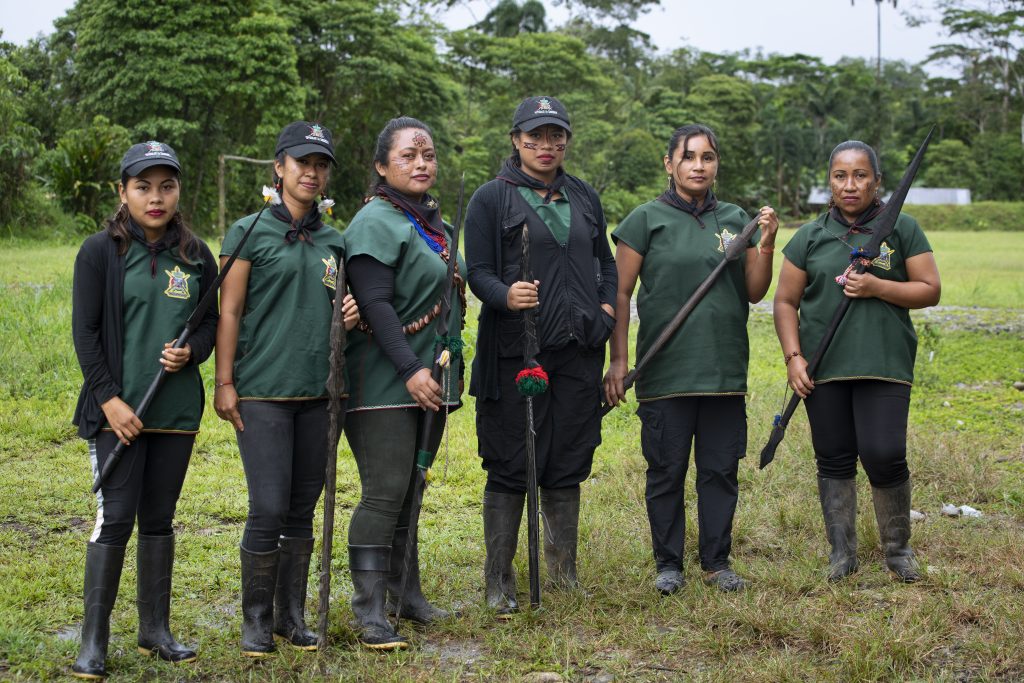
“There is also the more positive side of this story,” Adriane Esquivel Muelbert an expert in Amazon forest change at the University of Birmingham, told Mongabay in an email. “Some large areas of the Amazon are still very wet and not suffering from the increase in aridity. [I]f we control deforestation now we can avoid the Amazon tipping point.”
Protected areas and Indigenous territories are important strongholds for safeguarding the remaining Amazon Rainforest and meeting climate goals. Most of the deforestation and fires in the Amazon over the past five years have taken place outside of these key land-use designations, highlighting the importance of granting and honoring Indigenous land tenure and protected status.
Upcoming elections in Brazil could also have dramatic consequences for the fate of the Amazon, experts say. “The re-election of a [Bolsonaro] government that incentivizes deforestation can accelerate the Amazon tipping point drastically,” Muelbert said. “The election of former president Lula, currently the leading figure at the polls, is promising to bring deforestation rates down again in the Brazilian Amazon…hopefully moving the trajectory of Amazonian forests away from the tipping point.” Lula’s policies once helped to reduce annual deforestation by 82%, to the lowest rate since satellite monitoring began.
Ultimately, no one can predict how rapidly the forest will change past the tipping point, Lovejoy told Mongabay in 2019.“Will it be a long slide, or will the kinds of changes that are already being seen start happening with greater magnitude? … Let’s not find out by tipping it.”
Citations:
Finer, M., & Mamani, N. (2022). Amazon tipping point — Where are we? (164) Retrieved from MAAP website: https://www.maaproject.org/2022/amazon-tipping-point/
Lovejoy, T. E., & Nobre, C. (2018). Amazon tipping point. Science Advances, 4(2), eaat2340. doi:10.1126/sciadv.aat2340
Wunderling, N., Staal, A., Sakschewski, B., Hirota, M., Tuinenburg, O. A., Donges, J. F., … Winkelmann, R. (2022). Recurrent droughts increase risk of cascading tipping events by outpacing adaptive capacities in the Amazon rainforest. Proceedings of the National Academy of Sciences, 119(32), e2120777119. doi:10.1073/pnas.2120777119
Gatti, L. V., Basso, L. S., Miller, J. B., Gloor, M., Gatti Domingues, L., Cassol, H. L., … Neves, R. A. (2021). Amazonia as a carbon source linked to deforestation and climate change. Nature, 595(7867), 388-393. doi:10.1038/s41586-021-03629-6
Lovejoy, T. E., & Nobre, C. (2019). Amazon tipping point: Last chance for action. Science Advances, 5(12), eaba2949. doi:10.1126/sciadv.aba2949
Esquivel-Muelbert, A., Baker, T. R., Dexter, K. G., Lewis, S. L., Brienen, R. J., Feldpausch, T. R., … Phillips, O. L. (2019). Compositional response of Amazon forests to climate change. Global Change Biology, 25(1), 39-56. doi:10.1111/gcb.14413
Barkhordarian, A., Saatchi, S. S., Behrangi, A., Loikith, P. C., & Mechoso, C. R. (2019). A recent systematic increase in vapor pressure deficit over tropical South America. Scientific Reports, 9(1), 15331. doi:10.1038/s41598-019-51857-8
Vargas Zeppetello, L. R., Raftery, A. E., & Battisti, D. S. (2022). Probabilistic projections of increased heat stress driven by climate change. Communications Earth & Environment, 3(1), 183. doi:10.1038/s43247-022-00524-4
Song, X. P., Hansen, M. C., Potapov, P., Adusei, B., Pickering, J., Adami, M., … Tyukavina, A. (2021). Massive soybean expansion in South America since 2000 and implications for conservation. Nature Sustainability. doi:10.1038/s41893-021-00729-z
Staal, A., Flores, B. M., Aguiar, A. P. D., Bosmans, J. H., Fetzer, I., & Tuinenburg, O. A. (2020). Feedback between drought and deforestation in the Amazon. Environmental Research Letters, 15(4), 044024. doi:10.1088/1748-9326/ab738e
Banner image: Fire near the Manicoré River in Amazonas state in August 2022. Photo © Christian Braga / Greenpeace
Liz Kimbrough is a staff writer for Mongabay. Find her on Twitter: @lizkimbrough_

